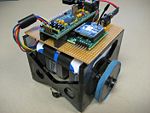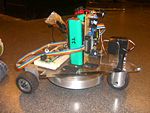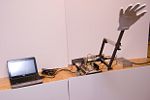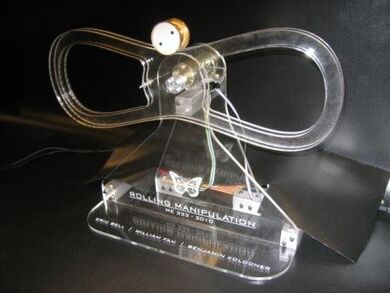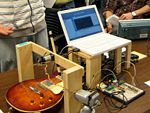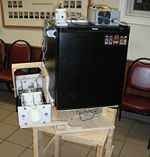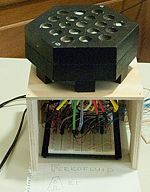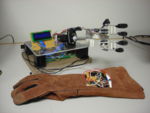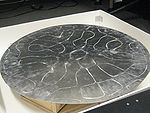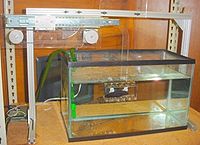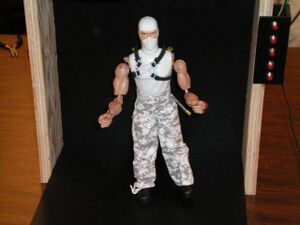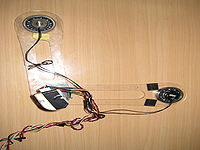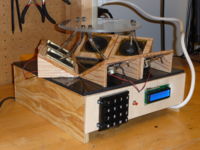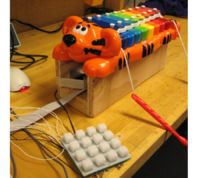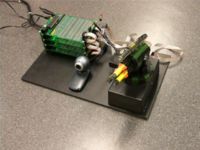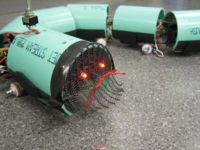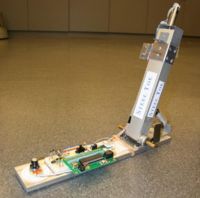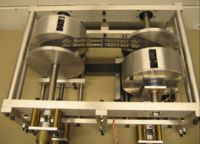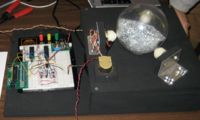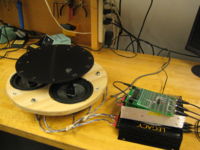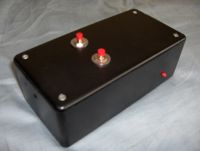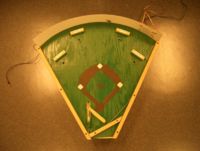Difference between revisions of "ME 333 final projects"
RaymondMui (talk | contribs) |
|||
| (211 intermediate revisions by 58 users not shown) | |||
| Line 1: | Line 1: | ||
'''[[ME 333 end of course schedule]]''' |
See the '''[[ME 333 end of course schedule]]'''. |
||
The ME 333 final projects shown below were all constructed from scratch during the last four weeks of the ten-week course. |
|||
Final projects for ME 333 in years 2000-2007 can be found |
|||
'''[http://lims.mech.northwestern.edu/~design/mechatronics/ here]'''. |
|||
'''Outstanding Projects, By Year, As Chosen by ME 333 Students''' |
|||
2010: J. Schultz and J. Ware: [[Differential Drive Mobile Robot]] |
|||
2009: C. Fryer, M. Kotowsky, and S. Wood: [[Mozart's Right Hand]] |
|||
2008: M. Straccia, M. Turpin, and A. Zhao: [[IR Tracker]] |
|||
2007: A. Elani, Y. C. Heng, and Z. Nelson: [http://www.mech.northwestern.edu/hartmann/ME333Files/ME333_FinalWebsites/HorseRace/Index.html Horse Racing Game] |
|||
2006: B. Crawford, D. Hsu, and J. Stegeman: [http://lims.mech.northwestern.edu/~design/mechatronics/2006/elevator/index.html The Elevator] |
|||
2005: A. Chen and A. Meruani: [http://lims.mech.northwestern.edu/~design/mechatronics/2005/skeet/ Laser Skeet Shooting] |
|||
2004: A. Loza, L. Norris, and E. Stuck: [http://lims.mech.northwestern.edu/~design/mechatronics/2004/Team25/ Wild West Shootout] |
|||
2003: A. Conaway, A. Huertas, T. Van Ravenswaay: [http://lims.mech.northwestern.edu/~design/mechatronics/2003/Team26/ Mechachess] |
|||
2002: B. Ajiboye, A. Cardenas, K. Kim, and D. Pakula: [http://lims.mech.northwestern.edu/~design/mechatronics/2002/Team21/ 3D Tic-Tac-D'oh!] |
|||
2001: K. Chigani, D. Choi, and B. Hoffmann: [http://lims.mech.northwestern.edu/~design/mechatronics/2001/Team13/ Gumball Geography] |
|||
2000: G. DeSanctis, M. Lee, and V. Rosso: video: [http://lims.mech.northwestern.edu/~lynch/courses/ME395/videos/team21.avi Hershey's Kisses Chocolate Sorter] |
|||
__TOC__ |
__TOC__ |
||
== ME 333 Final Projects 2008 == |
|||
== ME 333 Final Projects 2010 == |
|||
=== [[IR Tracker]] === |
|||
=== [[Differential Drive Mobile Robot]] === |
|||
[[Image:IR_Tracker_Main.jpg|right|thumb|200px]] |
|||
[[Image:Mobile_Robot_-_Parametric_-_Small.jpg|thumb|150px|Mobile Robot|right]] |
|||
The IR Tracker is a device that follows a moving infrared light. It continuously detects the position of an infrared emitter in two axises, and then tracks the emitter with a laser. |
|||
The goal of this project was to create a small differential drive mobile robot that would act as a low cost replacement for the popular E-Puck Robot. The robot uses hybrid stepper motors to allow it to track its position through odometry, has a laser cut acrylic chassis for easy replication and replacement, and a 1500 mAh, 13.2V battery pack for long run time. The robot also uses the NU32 board for its control logic and a XBee chip for communication. This [http://www.youtube.com/watch?v=5kB0zCvFP-g video] demonstrates the robot's operation. |
|||
'''Chosen the OUTSTANDING PROJECT by the students of ME 333.''' |
|||
<br clear=all> |
<br clear=all> |
||
=== [[ |
=== [[Haptic Gaming System]] === |
||
[[Image: |
[[Image:Haptikos.jpg|thumb|150px|Haptic Robot.|right]] |
||
An interactive gaming system that allows the user to physically feel a virtual world. The player controls the cursor by moving the red joystick. Two games were created to test the feedback system. The first is a side-scroller in which you avoid hitting moving blocks while collecting jewels. The second involves feeling a virtual shape displayed on the screen. This can be made more challenging by turning the display off and attempting to identify the shape. See our video demonstration on [http://www.youtube.com/watch?v=7j37NCYWHF8 YouTube]. |
|||
Here are a few words describing your project, just a teaser to go with the picture at the side. |
|||
<br clear=all> |
<br clear=all> |
||
=== [[Conservation of Angular Momentum Locomotion Robot (Fluffbot)]] === |
|||
=== [[Learning Oscillator]] === |
|||
[[Image: |
[[Image:Isometric view of Fluffbot guts.jpg|thumb|150px|The Fluffbot without Fluff.|right]] |
||
Cute fluffy robot that uses conservation of angular momentum to move forward and backward. The robot's momentum wheel accelerates in the floor-plane. The robot's net angular momentum must remain zero-- a steering wheel guides the Fluffbot to accelerate in the opposite direction. This moves the robot forward in a curved path. The momentum wheel and steering wheel then change direction of acceleration. This repeated process moves the Fluffbot forward in a sinusoidal path. [http://www.youtube.com/watch?v=utZnFJuoLag See Fluffbot move forward using sinusoidal motion of the momentum wheel and steering wheel.] |
|||
The Learning Oscillator is given a desired acceleration profile for a linear oscillating mass. It then 'learns' and adjusts the frequency of its force source so the oscillating mass eventually matches the desired acceleration profile. |
|||
<br clear=all> |
|||
=== [[Music from the Heart -- Music Suit]] === |
|||
[[Image:Music from the heart overview.jpg|thumb|150px|The "music suit" on James, with heart rate detector on his finger.|right]] |
|||
This project attempted to create a natural form of musical expression by connecting sensors to the body. Six tilt switches were attached to the wrist, ankles, and shoulders, each controlling a single pitch from the [http://en.wikipedia.org/wiki/Pentatonic_scale pentatonic scale]. The heart beat was obtained using [http://en.wikipedia.org/wiki/Photoplethysmograph photoplethysmography] on the user's finger, and this signal was used to strike a drum in sync with the heart beat. |
|||
For a video demonstration, click [http://www.youtube.com/watch?v=YyipByy7m6I here]. |
|||
<br clear=all> |
|||
=== [[High Speed Motor Control]] === |
|||
[[Image:2dofArmSetUp.jpg|thumb|150px|A 2-DOF robot arm.|right]] |
|||
The project suggested was to design a system for high speed motor control using the PIC 32. To demonstrate the motor control, a two degree of freedom (2-DOF) parallelogram robot arm was designed to follow paths specified in a MATLAB gui. This [http://www.youtube.com/watch?v=Ffun2e6hnVE video] shows the robot in action. |
|||
<br clear=all> |
|||
<!-- |
|||
=== [[Variable Frequency Electrosense]] === |
|||
[[Image:TR_JP_PP-sensor.jpg|thumb|150px|Variable Frequency Electrosense|right]] |
|||
Our objective was to build upon existing research being done at Northwestern utilizing Electrosense technology by testing if information can be derived from varying the emitter frequency. We sought to send sinusoidal waves at discrete frequencies between 100 Hz and 10 kHz and to read in the sensed wave using a PIC 32’s ADC. We then sent the gathered information to a PC for plotting and analysis. By mounting the sensor on a one dimensional linear actuator we are able to gather additional data about objects and perform object detection and identification algorithms. While our initial results have revealed exciting trends, farther research is necessary before any significant conclusions can be made. A [http://www.youtube.com/watch?v=PJY097L2m1M video] of the project is available on YouTube. |
|||
<br clear=all> |
|||
--> |
|||
=== [[Butterfly Rolling Manipulation]] === |
|||
[[Image:Butterflyteampic.jpg|right|upright=1.3|thumb|Butterfly Manipulator]] |
|||
The Butterfly emulates contact juggling by the stabilization of dynamic rolling. The apparatus rolls a cylinder by rotating the "hand" using a specific trajectory and is able to move the cylinder from one side to the other without losing contact. Videos of the Butterfly captured in high speed can be found [http://www.youtube.com/watch?v=lgmugtaGoTo here] and [http://www.youtube.com/watch?v=dtYv3qNz_LI here]. |
|||
<br clear=all> |
|||
=== [[Remote Controlled Wiitar]] === |
|||
[[Image:Wiitar.jpg|thumb|150px|Guitar Controlled by a wiimote: The Wiitar!|right]] |
|||
This project uses an array of solenoids to depress stings on the neck of a guitar. A motor over the strings of the guitar turns an arm which strums the instrument, playing the chord depressed by the solenoids. The system is controlled by a Wii Remote. You can see a [http://www.youtube.com/watch?v=67hausJ2xZ0 video] of the system in action. |
|||
<br clear=all> |
|||
=== [[Furuta Pendulum]] === |
|||
[[Image:Picture 1.png|thumb|150px|Furuta Pendulum|right]] |
|||
The Furuta pendulum, so named because it was first developed by Katsuhisa Furuta, is a rotational inverted pendulum. In other words, the horizontal arm, which rotates in the horizontal plane, drives the movement of the vertical arm, which is free to rotate in the vertical plane. Our objective was to build a Furuta pendulum that would hold the vertical arm up, as you can see from the [http://www.youtube.com/watch?v=7DtFLKgNUk4 demonstration video]. |
|||
<br clear=all> |
|||
=== [[Can Launching Fridge]] === |
|||
[[Image:27_Fridge.jpg|thumb|150px|Can launching fridge.|right]] |
|||
The goal of the can launching fridge was to create a fridge that would, when initiated by either a remote control or a wired push button, automatically load, aim, and fire a can to multiple predetermined locations. The fridge uses a combination of stepper motors, a DC motor, and solenoids to create the ultimate mix of convenience, fun, and refreshment. |
|||
<br clear=all> |
|||
=== [[6-DOF PPOD]] === |
|||
[[Image:Jd-cr-Assembly.jpg|thumb|150px|6-DOF shaker table.|right]] |
|||
The PPOD-mini is a miniaturized version of the Programmable Part-feeding Oscillatory Device ([http://lims.mech.northwestern.edu/projects/frictioninducedforcefields/index.htm PPOD]) found in the Laboratory for Intelligent Mechanical Systems (LIMS). |
|||
<br clear=all> |
|||
=== [[Ferrofluid Art Display]] === |
|||
[[Image:Kpmw_Ferrofluid.jpg|thumb|150px|Ferrofluid Art|right]] |
|||
The goal of this project was to create an interesting display using Ferrofluid, which forms interesting shapes in the presence of a magnetic field. The display consists of a hexagonal array of 19 solenoids attached to magnets. Depending on the motion of the solenoids, the fluid will either be smooth or show 'spikes'. |
|||
<br clear=all> |
|||
== ME 333 Final Projects 2009 == |
|||
=== [[Mozart's Right Hand]] === |
|||
[[Image:mrh_box.JPG|thumb|150px|Mozart's Right Hand|right]] |
|||
Mozart's Right Hand is a musical instrument capable of playing two full octaves of the [http://en.wikipedia.org/wiki/Diatonic_scale Diatonic Scale.] The user wears a glove on his right hand and uses motions of the hand and fingers to create different notes that are played with a speaker. The pitch of the note is controlled by the orientation of the user's hand as he rotates it ether from the wrist, the elbow, or the shoulder. The LCD on the front of the box tells the user the pitch that corresponds to his or her current hand orientation. When the user touches together his thumb and index finger, the speaker plays the tone. A [http://www.youtube.com/watch?v=vec-W4QeHQU video] of Mozart's Right Hand in action is available on YouTube. |
|||
'''Chosen the OUTSTANDING PROJECT by the students of ME 333.''' |
|||
<br clear=all> |
|||
=== [[Persistence-of-Vision Display]] === |
|||
[[Image:Persistence of Vison Display|right|thumb|150px]] |
|||
This is a fully customizable display implemented using the concept of Persistence of Vision. User-specified images (and even moving images) were displayed by rotating a column of LEDs at speeds faster than 300rpm. Each individual LED was modeled as a row of pixels. Conversely, the rotational position of the panel of LEDs represented the pixel columns of the display; the time interval and rotational speed determined the width of the pixel columns. |
|||
<br clear=all> |
|||
=== [[Rock Paper Scissors Machine]] === |
|||
[[Image:rps whole thing.JPG|thumb|150px|Rock Paper Scissors Machine|right]] |
|||
A machine that will play a fully functioning, intuitive game of [http://en.wikipedia.org/wiki/Rock-paper-scissors Rock/Paper/Scissors] (abbreviated as RPS) with a user. The machine is represented by a human-like hand, capable of seperate and independant wrist, arm, finger and thumb motion. The players' hand goes into a glove equipped with flex sensors, which wirelessly transmits data to the machine based on what the player chose. The machine then reads this data, randomly chooses a throw of its own, and displays what the machine threw, what the human threw, total win/loss/tie info, and winner/loser both on an [http://en.wikipedia.org/wiki/Lcd LCD] screen and in the form of a thumbs up/down/side motion. Video of the machine in action can be found [http://www.youtube.com/watch?v=xbLNBSTTrcE here.] |
|||
<br clear=all> |
|||
=== [[Three-speaker Chladni Patterns]] === |
|||
[[Image:chladni_660hz|right|thumb|150px]] |
|||
This project uses three speakers to generate shapes on a circular aluminum plate depending on which frequency the speakers are playing at. Once the speakers hit a resonant frequency of the plate, salt migrates to the nodes (zero amplitude) regions of the plate to form distinct patterns. |
|||
<br clear=all> |
|||
=== [[Basketball]] === |
|||
[[Image:Mechatronics2009Bball|right|thumb|150px]] |
|||
This project consists of a throwing arm propelled by a Pittman motor is mounted on a turntable and throws the ball into the "hoop." The hoop is wrapped in reflective tape and an IR emitter, receiver pair is used to sense where the IR is reflected most (the hoop with highly reflective tape). An ultrasonic sensor then pings the hoop for the distance of the hoop. With this information, the arm is able to "make a basket." A video can be found [http://www.youtube.com/watch?v=Y466dzP-qiY here]. |
|||
<br clear=all> |
|||
=== [[Robot Drummer]] === |
|||
[[Image:Robot_Drummer.jpg|thumb|400pix|right|Robot Drummer]] |
|||
The Robot Drummer is a device that demonstrates high-speed motor control by being able to drum when given commands. Through an RS232 cable, Matlab sends commands to a "master" PIC. The master then sends the commands to two "slave" PICs through I2C communication. The slaves take the commands and implement PID control of the motors. |
|||
<br clear=all> |
|||
=== [[Automated Fish Refuge]] === |
|||
[[Image:Entire Fish Refuge|right|thumb|200px]] |
|||
The automated fish refuge allows for the controlled movement of a fish refuge with the goal of recording specific behavior. The mechanical design is completely adjustable and allows adjustable degrees of oscillating movement and orientation of the refuge. The program is primarily in MATLAB for ease of use and the velocity profile can be a sine, square, triangle, or any function that the user inputs. [http://www.youtube.com/watch?v=wGOKujMhN88 Check out the video!] |
|||
<br clear=all> |
|||
=== [[Marionette]] === |
|||
[[Image: MarionettePicForIntro.JPG|right|thumb]] The Marionette Project focused on using RC Servos to make a puppet that would do a dance with the press of a button. There were 5 different dances programmed for the marionette, showcasing different styles of movement. The movement had 2 degrees of freedom thanks to using 5 bar linkages and 2 RC servos for each arm. Two more RC Servos were used on the back of the marionette to create the appearance of leg movement. The movements included a Hula dance, Jumping Jacks, and even some moves right out of Saturday Night Fever. |
|||
<br clear=all> |
|||
=== [[Monkeybot]] === |
|||
[[Image:monkeybot_pic|thumb|right|200px|Monkeybot]] |
|||
The monkeybot is a swinging robot capable of moving side to side and climbing. It consists of a two link, double pendulum system with an electro-magnet on each end. At the pivot is a DC motor, which provides an input torque and allows the swinging system to gain energy and climb. Check out the video of the monkeybot climbing [http://www.youtube.com/watch?v=TA2VcH_GDJ0 here] and a later brachiation video [http://www.youtube.com/watch?v=0hfwJEVQyeQ&feature=related here]. |
|||
<br clear=all> |
|||
=== [[PPOD-mini: 6-DOF Shaker]] === |
|||
[[Image:PPOD_mini.JPG|thumb|200x200 px|right|PPOD-mini 6-DOF Shaker]] |
|||
The PPOD-mini is a miniaturized version of the Programmable Part-feeding Oscillatory Device ([http://lims.mech.northwestern.edu/projects/frictioninducedforcefields/index.htm PPOD]) found in the Laboratory for Intelligent Mechanical Systems (LIMS) at Northwestern. The PPOD-mini utilizes six speakers that act like actuators. The speakers are connected to a acrylic plate via flexures of tygon and iron. In its current implementation, the phase of the speakers can be controlled independently, giving the device six degrees of freedom. The movement of objects placed on the acrylic plate can be controlled by changing the phases of the speakers. |
|||
<br clear=all> |
|||
=== [[Automated Xylophone]] === |
|||
[[Image:AutomatedXylophonePicture1.jpg|thumb|200x200 px|right|Automated Xylophone]] |
|||
The Automated Xylophone controls several solenoids which hit various pitches on an actual xylophone based on the note selected. The device has two main modes: using the keypad, a user can choose to either play notes in real time or store songs to be played back later. A video of the Automated Xylophone playing in real time mode can be found [http://www.youtube.com/watch?v=_ubpAEyq9kg here]. |
|||
<br clear=all> |
|||
=== [[Vision-based Cannon]] === |
|||
[[Image:SM_Gun_Camera_PIC_Setup.JPG|thumb|200x200 px|right|Vision-based Cannon]] |
|||
This project uses a webcam and Matlab to analyze an image and direct a modified USB Missile Launcher to fire at targets found in the image. |
|||
<br clear=all> |
|||
== ME 333 Final Projects 2008 == |
|||
=== [[IR Tracker]] === |
|||
[[Image:IR_Tracker_Main.jpg|right|thumb|200px]] |
|||
The IR Tracker (aka "Spot") is a device that follows a moving infrared light. It continuously detects the position of an infrared emitter in two axes, and then tracks the emitter with a laser. [[Media:MT_MS_AZ_TrackerVideo.mp4|See Spot Run.]] |
|||
'''Chosen the OUTSTANDING PROJECT by the students of ME 333.''' |
|||
<br clear=all> |
|||
=== [[Robot Snake]] === |
|||
[[Image:HLSSnakeMain.jpg|right|thumb|200px]] |
|||
This remote control robotic snake uses servo motors with a traveling sine wave motion profile to mimic serpentine motion. The robotic snake is capable of moving forward, left, right and in reverse. |
|||
[http://www.youtube.com/watch?v=r_GOOFLnI6w Video of the robot snake] |
|||
Featured on [http://blog.makezine.com/archive/2009/03/well_documented_robotic_snake.html Makezine.com]. |
|||
<br clear=all> |
<br clear=all> |
||
=== [[Programmable Stiffness Joint]] === |
=== [[Programmable Stiffness Joint]] === |
||
[[Image:SteelToePic2.jpg|thumb|200px|The 'Steel Toe' programmable stiffness joint|right]] |
|||
The Programmable Stiffness Joint varies rotational stiffness as desired by the user. It is the first step in modeling the mechanical impedance of the human ankle joint (both stiffness and damping) for the purpose of determining the respective breakdown of the two properties over the gait cycle. |
The Programmable Stiffness Joint varies rotational stiffness as desired by the user. It is the first step in modeling the mechanical impedance of the human ankle joint (both stiffness and damping) for the purpose of determining the respective breakdown of the two properties over the gait cycle. |
||
<br clear=all> |
<br clear=all> |
||
=== [[Magnetic based sample purification]] === |
=== [[Magnetic based sample purification]] === |
||
| Line 42: | Line 241: | ||
=== [[ |
=== [[Continuously Variable Transmission]] === |
||
[[image:CVT_system.JPG|thumb|200px]] |
|||
This prototype is a proof of concept model of a variable ratio transmission to be implemented in the 2008-2009 Formula SAE competition vehicle. The gear ratio is determined by the distances between the pulley halves which are controllable electronically. |
|||
<br clear=all> |
|||
=== [[Granular Flow Rotating Sphere]] === |
|||
[[Image:Team-21-main-picture.JPG|right|thumb|200px]] |
|||
This device will be used to study the granular flow of particles within a rotating sphere. The sphere is filled with grains of varying size and then rotated about two different axes according to a series of position and angular velocity inputs. |
|||
<br clear=all> |
|||
=== [[Vibratory Clock]] === |
|||
[[Image:Vibratory_Clock.jpg|right|thumb|Vibratory Clock|200px]] |
|||
The Vibratory Clock allows a small object to act as an hour "hand" on a horizontal circular platform that is actuated from underneath by three speakers. The object slides around the circular platform, impelled by friction forces due to the vibration. [http://www.youtube.com/watch?v=KhgTNCfdwZw Check it out!] |
|||
<br clear=all> |
|||
=== [[WiiMouse]] === |
|||
[[Image:HPIM1027.jpg|right|thumb|200px]] |
|||
The WiiMouse is a handheld remote that can be used to move a cursor on a windows-based PC, via accelerometer input captured through device movement. |
|||
<br clear=all> |
|||
=== [[Intelligent Oscillation Controller]] === |
|||
[[image:ME333_learning_oscillator.jpg|thumb|200px]] |
|||
This device "learns" a forcing function that is applied to a spring and mass system to match an arbitrary, periodic acceleration profile. |
|||
<br clear=all> |
|||
=== [[Baseball]] === |
|||
[[Image:Baseball_Playfield.jpg|Sweet Baseball Game|right|thumb|200px]] |
|||
An interactive baseball game inspired by pinball, featuring pitching, batting, light up bases and a scoreboard to keep track of the game. |
|||
<br clear=all> |
|||
=== [[Ball Balancing Challenge]] === |
|||
[[Image:Ballbalancechallenge.JPG|right|thumb|200px]] |
|||
An interactive game involving ball balancing on a touchscreen with touchscreen feedback and joystick action. |
|||
<br clear=all> |
<br clear=all> |
||
Latest revision as of 13:17, 18 April 2010
See the ME 333 end of course schedule.
The ME 333 final projects shown below were all constructed from scratch during the last four weeks of the ten-week course.
Final projects for ME 333 in years 2000-2007 can be found here.
Outstanding Projects, By Year, As Chosen by ME 333 Students
2010: J. Schultz and J. Ware: Differential Drive Mobile Robot
2009: C. Fryer, M. Kotowsky, and S. Wood: Mozart's Right Hand
2008: M. Straccia, M. Turpin, and A. Zhao: IR Tracker
2007: A. Elani, Y. C. Heng, and Z. Nelson: Horse Racing Game
2006: B. Crawford, D. Hsu, and J. Stegeman: The Elevator
2005: A. Chen and A. Meruani: Laser Skeet Shooting
2004: A. Loza, L. Norris, and E. Stuck: Wild West Shootout
2003: A. Conaway, A. Huertas, T. Van Ravenswaay: Mechachess
2002: B. Ajiboye, A. Cardenas, K. Kim, and D. Pakula: 3D Tic-Tac-D'oh!
2001: K. Chigani, D. Choi, and B. Hoffmann: Gumball Geography
2000: G. DeSanctis, M. Lee, and V. Rosso: video: Hershey's Kisses Chocolate Sorter
ME 333 Final Projects 2010
Differential Drive Mobile Robot
The goal of this project was to create a small differential drive mobile robot that would act as a low cost replacement for the popular E-Puck Robot. The robot uses hybrid stepper motors to allow it to track its position through odometry, has a laser cut acrylic chassis for easy replication and replacement, and a 1500 mAh, 13.2V battery pack for long run time. The robot also uses the NU32 board for its control logic and a XBee chip for communication. This video demonstrates the robot's operation.
Chosen the OUTSTANDING PROJECT by the students of ME 333.
Haptic Gaming System
An interactive gaming system that allows the user to physically feel a virtual world. The player controls the cursor by moving the red joystick. Two games were created to test the feedback system. The first is a side-scroller in which you avoid hitting moving blocks while collecting jewels. The second involves feeling a virtual shape displayed on the screen. This can be made more challenging by turning the display off and attempting to identify the shape. See our video demonstration on YouTube.
Conservation of Angular Momentum Locomotion Robot (Fluffbot)
Cute fluffy robot that uses conservation of angular momentum to move forward and backward. The robot's momentum wheel accelerates in the floor-plane. The robot's net angular momentum must remain zero-- a steering wheel guides the Fluffbot to accelerate in the opposite direction. This moves the robot forward in a curved path. The momentum wheel and steering wheel then change direction of acceleration. This repeated process moves the Fluffbot forward in a sinusoidal path. See Fluffbot move forward using sinusoidal motion of the momentum wheel and steering wheel.
Music from the Heart -- Music Suit
This project attempted to create a natural form of musical expression by connecting sensors to the body. Six tilt switches were attached to the wrist, ankles, and shoulders, each controlling a single pitch from the pentatonic scale. The heart beat was obtained using photoplethysmography on the user's finger, and this signal was used to strike a drum in sync with the heart beat.
For a video demonstration, click here.
High Speed Motor Control
The project suggested was to design a system for high speed motor control using the PIC 32. To demonstrate the motor control, a two degree of freedom (2-DOF) parallelogram robot arm was designed to follow paths specified in a MATLAB gui. This video shows the robot in action.
Butterfly Rolling Manipulation
The Butterfly emulates contact juggling by the stabilization of dynamic rolling. The apparatus rolls a cylinder by rotating the "hand" using a specific trajectory and is able to move the cylinder from one side to the other without losing contact. Videos of the Butterfly captured in high speed can be found here and here.
Remote Controlled Wiitar
This project uses an array of solenoids to depress stings on the neck of a guitar. A motor over the strings of the guitar turns an arm which strums the instrument, playing the chord depressed by the solenoids. The system is controlled by a Wii Remote. You can see a video of the system in action.
Furuta Pendulum
The Furuta pendulum, so named because it was first developed by Katsuhisa Furuta, is a rotational inverted pendulum. In other words, the horizontal arm, which rotates in the horizontal plane, drives the movement of the vertical arm, which is free to rotate in the vertical plane. Our objective was to build a Furuta pendulum that would hold the vertical arm up, as you can see from the demonstration video.
Can Launching Fridge
The goal of the can launching fridge was to create a fridge that would, when initiated by either a remote control or a wired push button, automatically load, aim, and fire a can to multiple predetermined locations. The fridge uses a combination of stepper motors, a DC motor, and solenoids to create the ultimate mix of convenience, fun, and refreshment.
6-DOF PPOD
The PPOD-mini is a miniaturized version of the Programmable Part-feeding Oscillatory Device (PPOD) found in the Laboratory for Intelligent Mechanical Systems (LIMS).
Ferrofluid Art Display
The goal of this project was to create an interesting display using Ferrofluid, which forms interesting shapes in the presence of a magnetic field. The display consists of a hexagonal array of 19 solenoids attached to magnets. Depending on the motion of the solenoids, the fluid will either be smooth or show 'spikes'.
ME 333 Final Projects 2009
Mozart's Right Hand
Mozart's Right Hand is a musical instrument capable of playing two full octaves of the Diatonic Scale. The user wears a glove on his right hand and uses motions of the hand and fingers to create different notes that are played with a speaker. The pitch of the note is controlled by the orientation of the user's hand as he rotates it ether from the wrist, the elbow, or the shoulder. The LCD on the front of the box tells the user the pitch that corresponds to his or her current hand orientation. When the user touches together his thumb and index finger, the speaker plays the tone. A video of Mozart's Right Hand in action is available on YouTube.
Chosen the OUTSTANDING PROJECT by the students of ME 333.
Persistence-of-Vision Display
This is a fully customizable display implemented using the concept of Persistence of Vision. User-specified images (and even moving images) were displayed by rotating a column of LEDs at speeds faster than 300rpm. Each individual LED was modeled as a row of pixels. Conversely, the rotational position of the panel of LEDs represented the pixel columns of the display; the time interval and rotational speed determined the width of the pixel columns.
Rock Paper Scissors Machine
A machine that will play a fully functioning, intuitive game of Rock/Paper/Scissors (abbreviated as RPS) with a user. The machine is represented by a human-like hand, capable of seperate and independant wrist, arm, finger and thumb motion. The players' hand goes into a glove equipped with flex sensors, which wirelessly transmits data to the machine based on what the player chose. The machine then reads this data, randomly chooses a throw of its own, and displays what the machine threw, what the human threw, total win/loss/tie info, and winner/loser both on an LCD screen and in the form of a thumbs up/down/side motion. Video of the machine in action can be found here.
Three-speaker Chladni Patterns
This project uses three speakers to generate shapes on a circular aluminum plate depending on which frequency the speakers are playing at. Once the speakers hit a resonant frequency of the plate, salt migrates to the nodes (zero amplitude) regions of the plate to form distinct patterns.
Basketball
This project consists of a throwing arm propelled by a Pittman motor is mounted on a turntable and throws the ball into the "hoop." The hoop is wrapped in reflective tape and an IR emitter, receiver pair is used to sense where the IR is reflected most (the hoop with highly reflective tape). An ultrasonic sensor then pings the hoop for the distance of the hoop. With this information, the arm is able to "make a basket." A video can be found here.
Robot Drummer
The Robot Drummer is a device that demonstrates high-speed motor control by being able to drum when given commands. Through an RS232 cable, Matlab sends commands to a "master" PIC. The master then sends the commands to two "slave" PICs through I2C communication. The slaves take the commands and implement PID control of the motors.
Automated Fish Refuge
The automated fish refuge allows for the controlled movement of a fish refuge with the goal of recording specific behavior. The mechanical design is completely adjustable and allows adjustable degrees of oscillating movement and orientation of the refuge. The program is primarily in MATLAB for ease of use and the velocity profile can be a sine, square, triangle, or any function that the user inputs. Check out the video!
Marionette
The Marionette Project focused on using RC Servos to make a puppet that would do a dance with the press of a button. There were 5 different dances programmed for the marionette, showcasing different styles of movement. The movement had 2 degrees of freedom thanks to using 5 bar linkages and 2 RC servos for each arm. Two more RC Servos were used on the back of the marionette to create the appearance of leg movement. The movements included a Hula dance, Jumping Jacks, and even some moves right out of Saturday Night Fever.
Monkeybot
The monkeybot is a swinging robot capable of moving side to side and climbing. It consists of a two link, double pendulum system with an electro-magnet on each end. At the pivot is a DC motor, which provides an input torque and allows the swinging system to gain energy and climb. Check out the video of the monkeybot climbing here and a later brachiation video here.
PPOD-mini: 6-DOF Shaker
The PPOD-mini is a miniaturized version of the Programmable Part-feeding Oscillatory Device (PPOD) found in the Laboratory for Intelligent Mechanical Systems (LIMS) at Northwestern. The PPOD-mini utilizes six speakers that act like actuators. The speakers are connected to a acrylic plate via flexures of tygon and iron. In its current implementation, the phase of the speakers can be controlled independently, giving the device six degrees of freedom. The movement of objects placed on the acrylic plate can be controlled by changing the phases of the speakers.
Automated Xylophone
The Automated Xylophone controls several solenoids which hit various pitches on an actual xylophone based on the note selected. The device has two main modes: using the keypad, a user can choose to either play notes in real time or store songs to be played back later. A video of the Automated Xylophone playing in real time mode can be found here.
Vision-based Cannon
This project uses a webcam and Matlab to analyze an image and direct a modified USB Missile Launcher to fire at targets found in the image.
ME 333 Final Projects 2008
IR Tracker
The IR Tracker (aka "Spot") is a device that follows a moving infrared light. It continuously detects the position of an infrared emitter in two axes, and then tracks the emitter with a laser. See Spot Run.
Chosen the OUTSTANDING PROJECT by the students of ME 333.
Robot Snake
This remote control robotic snake uses servo motors with a traveling sine wave motion profile to mimic serpentine motion. The robotic snake is capable of moving forward, left, right and in reverse.
Featured on Makezine.com.
Programmable Stiffness Joint
The Programmable Stiffness Joint varies rotational stiffness as desired by the user. It is the first step in modeling the mechanical impedance of the human ankle joint (both stiffness and damping) for the purpose of determining the respective breakdown of the two properties over the gait cycle.
Magnetic based sample purification
Continuously Variable Transmission
This prototype is a proof of concept model of a variable ratio transmission to be implemented in the 2008-2009 Formula SAE competition vehicle. The gear ratio is determined by the distances between the pulley halves which are controllable electronically.
Granular Flow Rotating Sphere
This device will be used to study the granular flow of particles within a rotating sphere. The sphere is filled with grains of varying size and then rotated about two different axes according to a series of position and angular velocity inputs.
Vibratory Clock
The Vibratory Clock allows a small object to act as an hour "hand" on a horizontal circular platform that is actuated from underneath by three speakers. The object slides around the circular platform, impelled by friction forces due to the vibration. Check it out!
WiiMouse
The WiiMouse is a handheld remote that can be used to move a cursor on a windows-based PC, via accelerometer input captured through device movement.
Intelligent Oscillation Controller
This device "learns" a forcing function that is applied to a spring and mass system to match an arbitrary, periodic acceleration profile.
Baseball
An interactive baseball game inspired by pinball, featuring pitching, batting, light up bases and a scoreboard to keep track of the game.
Ball Balancing Challenge
An interactive game involving ball balancing on a touchscreen with touchscreen feedback and joystick action.
